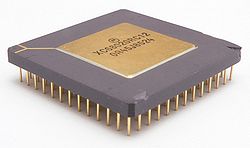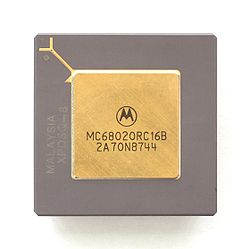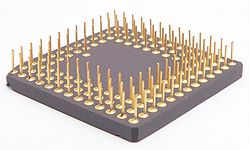
Motorola 68020
Encyclopedia

32-bit
The range of integer values that can be stored in 32 bits is 0 through 4,294,967,295. Hence, a processor with 32-bit memory addresses can directly access 4 GB of byte-addressable memory....
microprocessor
Microprocessor
A microprocessor incorporates the functions of a computer's central processing unit on a single integrated circuit, or at most a few integrated circuits. It is a multipurpose, programmable device that accepts digital data as input, processes it according to instructions stored in its memory, and...
from Motorola
Motorola
Motorola, Inc. was an American multinational telecommunications company based in Schaumburg, Illinois, which was eventually divided into two independent public companies, Motorola Mobility and Motorola Solutions on January 4, 2011, after losing $4.3 billion from 2007 to 2009...
, released in 1984. It is the successor to the Motorola 68010
Motorola 68010
The Motorola MC68010 processor is a 16/32-bit microprocessor from Motorola, released in 1982. In line with the Motorola 68000 naming convention, it is usually just referred to as the 010 ....
and is succeeded by the Motorola 68030
Motorola 68030
The Motorola 68030 is a 32-bit microprocessor in Motorola's 68000 family. It was released in 1987. The 68030 was the successor to the Motorola 68020, and was followed by the Motorola 68040. In keeping with general Motorola naming, this CPU is often referred to as the 030 .The 68030 features on-chip...
. A lower cost version was also made available, known as the 68EC020.
Description

Improvements over 68010
The 68020 added many improvements to the 68010 including a 32-bit arithmetic logic unitArithmetic logic unit
In computing, an arithmetic logic unit is a digital circuit that performs arithmetic and logical operations.The ALU is a fundamental building block of the central processing unit of a computer, and even the simplest microprocessors contain one for purposes such as maintaining timers...
(ALU), external data bus and address bus, and new instructions and addressing modes. The 68020 (and 68030) had a proper three-stage pipeline. Though 68010 had a loop mode, it was little used. The 68020 replaced this with a proper instruction cache of 256 bytes, the first 68k series processor to feature proper onboard cache memory.
The previous 68000 and 68010 processors could only access word (16 bit) and longword (32 bit) data if it were word-aligned (located at an address that is evenly divisible by 2). The 68020 had no alignment restrictions on data access. However, unaligned longword accesses were often much slower than aligned accesses.
Coprocessor support
The MC68020 has a coprocessor interface supporting up to eight coprocessors. The main CPU recognizes "F-line" instructions (with the four most significant opcode bits all one), and uses special bus cycles to interact with a coprocessor to execute these instructions. Two types of coprocessors were defined, the floating point unit (MC68881Motorola 68881
The Motorola 68881 and Motorola 68882 were floating-point coprocessor chips that were used in some computer systems in conjunction with the 68020 or 68030 CPUs. The addition of one of these chips added substantial cost to the computer, but added a floating point unit that could rapidly perform...
or MC68882 FPU) and the paged memory management unit (MC68851
Motorola 68851
The Motorola 68851 is an external Memory Management Unit which is designed to provide paged memory support for the 68020 using that processor's coprocessor interface...
PMMU). Only one PMMU can be used with a CPU. In principle multiple FPUs could be used with a CPU, but it was not commonly done. The coprocessor interface is asynchronous, so it is possible to run the coprocessors at a different clock rate than the CPU.
Multiprocessing features
Multiprocessing support was implemented externally by the use of a RMC pin to indicate an indivisible read-modify-writeRead-modify-write
In computer science, read-modify-write is a class of atomic operations such as test-and-set, fetch-and-add, and compare-and-swap which both read a memory location and write a new value into it simultaneously, either with a completely new value or some function of the previous value. These...
cycle in progress. All other processors had to hold off memory accesses until the cycle was complete. Software support for multiprocessing included the TAS
Test-and-set
In computer science, the test-and-set instruction is an instruction used to write to a memory location and return its old value as a single atomic operation. If multiple processes may access the same memory, and if a process is currently performing a test-and-set, no other process may begin...
, CAS
Compare-and-swap
In computer science, the compare-and-swap CPU instruction is a special instruction that atomically compares the contents of a memory location to a given value and, only if they are the same, modifies the contents of that memory location to a given new value...
and CAS2 instructions.
In a multiprocessor system, coprocessors could not be shared between CPUs. To avoid problems with returns from coprocessor, bus error, and address error exceptions, it was generally necessary in a multiprocessor system for all CPUs to be the same model, and for all FPUs to be the same model as well.
Instruction set
The new instructions included some minor improvements and extensions to the supervisor state, several instructions for software management of a multiprocessing system (which were removed in the 68060), some support for high-level languages which did not get used much (and was removed from future 680x0 processors), bigger multiply (32×32→64 bits) and divide (64÷32→32 bits quotient and 32 bits remainder) instructions, and bit field manipulations.While the 68000 had 'supervisor mode', it did not meet the Popek and Goldberg virtualization requirements
Popek and Goldberg virtualization requirements
The Popek and Goldberg virtualization requirements are a set of conditions sufficient for a computer architecture to support system virtualization efficiently. They were introduced by Gerald J. Popek and Robert P. Goldberg in their 1974 article "Formal Requirements for Virtualizable Third...
due to the single instruction 'MOVE from SR' being unprivileged but sensitive. Under the 68010 and later, this was made privileged, to better support virtualization software.
Addressing modes
The new addressing modes added scaled indexing and another level of indirection to many of the pre-existing modes, and added quite a bit of flexibility to various indexing modes and operations. Though it was not intended, these new modes made the 68020 very suitable for page printing; most laser printers in the early '90s had a 68EC020 at their core.The 68020 had a minimal 256 byte direct-mapped instruction cache, arranged as 64 four-byte entries. Although small, it still made a significant difference in the performance of many applications. The resulting decrease in bus traffic was particularly important in systems relying heavily on DMA
Direct memory access
Direct memory access is a feature of modern computers that allows certain hardware subsystems within the computer to access system memory independently of the central processing unit ....
.

Usage
The 68020 was used in the AppleApple Computer
Apple Inc. is an American multinational corporation that designs and markets consumer electronics, computer software, and personal computers. The company's best-known hardware products include the Macintosh line of computers, the iPod, the iPhone and the iPad...
Macintosh II
Macintosh II
The Apple Macintosh II was the first personal computer model of the Macintosh II series in the Apple Macintosh line and the first Macintosh to support a color display.- History :...
and Macintosh LC
Macintosh LC
The Macintosh LC was Apple Computer's product family of low-end consumer Macintosh personal computers in the early 1990s. The original Macintosh LC was released in 1990 and was the first affordable color-capable Macintosh. Due to its affordability and Apple II compatibility the LC was adopted...
personal computer
Personal computer
A personal computer is any general-purpose computer whose size, capabilities, and original sales price make it useful for individuals, and which is intended to be operated directly by an end-user with no intervening computer operator...
s, as well as Sun 3 workstations and the Hewlett Packard 8711 Series Network Analyzers, and the Alpha Microsystems
Alpha Microsystems
Alpha Microsystems is a computer company founded in 1977 by John French, Dick Wilcox and Bob Hitchcock. The first Alpha Micro computer was the S-100 AM-100, based upon the WD16 microprocessor chipset from Western Digital...
AM-2000.
It is also the processor used on board TGV
TGV
The TGV is France's high-speed rail service, currently operated by SNCF Voyages, the long-distance rail branch of SNCF, the French national rail operator....
trains to decode signalling information which is sent to the trains through the rails. It is further being used in the flight control systems of the Eurofighter Typhoon
Eurofighter Typhoon
The Eurofighter Typhoon is a twin-engine, canard-delta wing, multirole combat aircraft, designed and built by a consortium of three companies: EADS, Alenia Aeronautica and BAE Systems; working through a holding company, Eurofighter GmbH, which was formed in 1986...
combat aircraft.
For more information on the instructions and architecture see Motorola 68000
Motorola 68000
The Motorola 68000 is a 16/32-bit CISC microprocessor core designed and marketed by Freescale Semiconductor...
.
Variant

Microprocessor
A microprocessor incorporates the functions of a computer's central processing unit on a single integrated circuit, or at most a few integrated circuits. It is a multipurpose, programmable device that accepts digital data as input, processes it according to instructions stored in its memory, and...
from Motorola
Motorola
Motorola, Inc. was an American multinational telecommunications company based in Schaumburg, Illinois, which was eventually divided into two independent public companies, Motorola Mobility and Motorola Solutions on January 4, 2011, after losing $4.3 billion from 2007 to 2009...
. It is a lower cost version of the Motorola 68020. The main difference between the two is that the 68EC020 only has a 24-bit address bus, rather than the 32-bit address bus of the full 68020, and thus is only able to address 16 MB of RAM.
The Commodore
Commodore International
Commodore is the commonly used name for Commodore Business Machines , the U.S.-based home computer manufacturer and electronics manufacturer headquartered in West Chester, Pennsylvania, which also housed Commodore's corporate parent company, Commodore International Limited...
Amiga 1200
Amiga 1200
The Amiga 1200, or A1200 , was Commodore International's third-generation Amiga computer, aimed at the home market...
computer and the Amiga CD32
Amiga CD32
The Amiga CD32, styled "CD32" , was the first 32-bit CD-ROM based video game console released in western Europe, Australia, Canada and Brazil. It was first announced at the Science Museum in London, United Kingdom on 16 July 1993, and was released in September of the same year...
games console used the cost-reduced 68EC020; the Namco System 22
Namco System 22
The Namco System 22 is the successor to the Namco System 21 arcade system board co-designed with the assistance of graphics & simulation experts Evans & Sutherland. It was first released in 1993 with the game Ridge Racer...
arcade board has also used this processor.
It found use in laser printers. Apple used it in the QMS PS 410 and the LaserWriter II-NTX. Kodak used it in the Ektaplus 7016PS, and Dataproducts used it in the LZR 1260.
Technical data
| Formal name | MC68020 |
| Work frequency | (minimum 8 MHz, no on-chip clock generation) |
| Voltage supply | |
| Maximum power | |
| Production process | HCMOS, 3/8" silicon piece |
| Chip carrier Chip carrier A chip carrier, also known as a chip container or chip package, is a container for a transistor or an integrated circuit. The carrier usually provides metal leads, or "pins", which are sturdy enough to electrically and mechanically connect the fragile chip to a circuit board. This connection may be... |
PGA 169 Pin grid array A pin grid array, often abbreviated PGA, is a type of integrated circuit packaging. In a PGA, the package is square or roughly square, and the pins are arranged in a regular array on the underside of the package... (114 pins used) (53 °C/W without heatsink) |
| Address bus | 32-bit (4 GB directly linear accessible) |
| Data bus | 32-bit |
| Instruction set Instruction set An instruction set, or instruction set architecture , is the part of the computer architecture related to programming, including the native data types, instructions, registers, addressing modes, memory architecture, interrupt and exception handling, and external I/O... |
CISC |
| Cache | ICache |
| Register |
|
| Transistors | |
| Performance |

